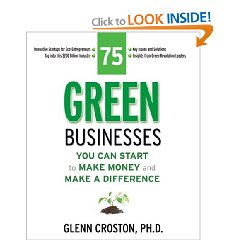
Glenn Croston
This book is everything I could have wanted and more–it exceeded expecations. For each of 75 “opportunities” sorted within eleven chapters it provides a summary table (Market Need, Mission, Knowledge to Start, Capital Rquired, Timing to Start, and Special Challenges, along with a multi-page discussion and a variety of “sidebar” elements that vary but generally address Related Trends, In the Long Run, Green Leader, Industry Information, Information Resource, Eco-Tip, or Eco-Issue.
This is a book that can be read quickly to focus in as I did on an opportunity that I believe anyone could pursue in any area, as a Sustainability Savings Officer (the author uses Chief Sustainability Officer which I consider too grandiose). The value propositiion here is straight-forward: go into any client, offer a free evaluation and recommendations of remediation measures, and collect 20% of the savings in year one, 10% in year two, 5% in year three, and then repeat the cycle.
I have this book set aside to go through a second time, for two reasons: it has a ton of interesting information that I picked up “in passing” and want to go back to (for example, most chemists are not trained in toxicology, bottled water costs 10,000 times more than tap water, use Google Earth to identify best neighborhoods for offering energy saving white roof service, and on an on.
The second reason I want to go through this book a second time is because many of the opportunities that are listed can actually be used within a localized web site to become the “go to” local area consultant for all matters having to do with greening, including LEEDs certification, bioplastics substitution, increased receycling, paper reduction, etcetera, etcetera, etcetera. This book, in other words, can become “Ref A” for a sustainability services and support consultancy.
I liked the author's observation that energy is everywhere, we just have not figured out how to tap into it. This ties in with my being enormously impressed by Nokia's new cellular telephones that do not need electricity for life support, but instead recharge themselves with ambient energy–combine that with the new foot-powered battery packs (soliders on the march charge the batteries, they can be used with radios, etcetera) and mobile solar power panels, you have the makings of “jacking in” the rest of the world, and using information as a substitute for violence and wealth, and as an educational platform for unleashing the entrepreneurial energies of the five billion poor.
This is a GREAT book for those who accept it as a tutorial. It is not the be all end all but I for one am VERY imprressed. For the larger picture and other impressions, consider the books below (or just my summary reviews).
Biomimicry: Innovation Inspired by Nature
Cradle to Cradle: Remaking the Way We Make Things
The Design of Business: Why Design Thinking is the Next Competitive Advantage
Ecological Economics: Principles And Applications
Green to Gold: How Smart Companies Use Environmental Strategy to Innovate, Create Value, and Build Competitive Advantage
Natural Capitalism: Creating the Next Industrial Revolution
The Resilient Earth: Science, Global Warming and the Fate of Humanity




